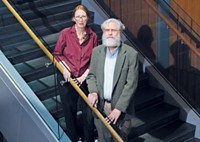Advertisement
Grab your lab coat. Let's get started
Welcome!
Welcome!
Create an account below to get 6 C&EN articles per month, receive newsletters and more - all free.
It seems this is your first time logging in online. Please enter the following information to continue.
As an ACS member you automatically get access to this site. All we need is few more details to create your reading experience.
Not you? Sign in with a different account.
Not you? Sign in with a different account.
ERROR 1
ERROR 1
ERROR 2
ERROR 2
ERROR 2
ERROR 2
ERROR 2
Password and Confirm password must match.
If you have an ACS member number, please enter it here so we can link this account to your membership. (optional)
ERROR 2
ACS values your privacy. By submitting your information, you are gaining access to C&EN and subscribing to our weekly newsletter. We use the information you provide to make your reading experience better, and we will never sell your data to third party members.
Genomics
Will Nantucket vote to allow genetically altered mice to control Lyme disease?
A lab’s deference to the community garners a preliminary yes vote from a critic of the experiment
by Rick Mullin
August 27, 2018
| A version of this story appeared in
Volume 96, Issue 34

“If in the first act you have hung a pistol on the wall,” the Russian playwright Anton Chekhov wrote, “then in the following one it should be fired. Otherwise don’t put it there.”
COVER STORY
Will Nantucket vote to allow genetically altered mice to control Lyme disease?
Often referred to as Chekhov’s principle, the physician-dramatist’s stage direction has been applied metaphorically to situations in which something potentially dangerous is brought into the world that, once introduced, will inevitably deliver the bad result.
Danica Connors of Nantucket, Mass., likes it to describe Massachusetts Institute of Technology professor Kevin Esvelt’s proposal to use genetically modified mice in a scheme that may reduce Lyme disease on her island and the nearby island of Martha’s Vineyard.
A Nantucket steering committee for the project has already approved preliminary work at MIT, and the mice will most likely be created before the town’s vote on whether to allow them to be loosed on the island. Regardless of the vote, those mice will go somewhere, Connors says—most likely Martha’s Vineyard if Nantucket votes no. Otherwise, somewhere else.
“And the second you release something like that, you have no idea how it’s going to modulate or how you will contain it,” she says.
Connors is an herbalist who, like nearly half of Nantucket’s inhabitants, has contracted a tick-borne disease. She is firmly opposed to the project, which aims to use the CRISPR/Cas9 technology to make white-footed mice, the hosts from which ticks pick up the Lyme disease pathogen, immune to that pathogen. It is anticipated that the modified mice over several generations will spread the immunity to the entire mouse population on the island.

“You’re Band-Aiding and avoiding the problem by genetically modifying a mouse instead of dealing with the actual issue, which is how we are treating our environment, how we eat, how we work, how we sleep,” Connors says. She says that she and clients she advises are managing their disease with few or no symptoms through lifestyle choices, without drugs or even herbs.
Moreover, Connors does not dismiss fringe theories that Lyme disease was itself created through genetic engineering as a biological weapon.
Though she considers herself firm in her position, Connors is very interested in the mouse project. She attended the first meeting on Nantucket with people from MIT. She joined the steering committee after being invited to do so by Esvelt, who sought input from opponents of the scheme. That committee voted unanimously—Connors included—to begin preliminary science in Cambridge, Mass. Connors is interested to see if the science works in a test tube, she says, but she will vote to stop the project before engineering mice begins.
Supporting the project at this stage also comports with Connors’s interest in a democratic process—one that will give the inhabitants of the island a say in whether the project proceeds. “The reason I am on this committee is Kevin Esvelt’s ability to communicate,” Connors says. “What I appreciate is that this is science putting the control of what happens in the end in the hands of the community. This is the first time I have ever seen that.”
Advertisement
Esvelt sees the effort as an experiment in democratic deployment of innovative science. Finding a means of controlling Lyme disease is the project’s raison d’être, “but we’re also changing the norms of science, so it is directly in service to something that the people believe to be important while ensuring that there is collective scrutiny of increasingly powerful technologies.”
He and Connors note that it will be a long experiment—it will be seven to 10 years before mice would be allowed into Nantucket’s environment. Along the way, there would be field tests done on a series of small islands with no human inhabitants. And there will be several other votes that could put a halt to the effort.
If the final vote goes against the project? “There are other islands,” Esvelt says. MIT is already putting feelers out to the select board of Gosnold, a town comprising the nearby Elizabeth Islands, regarding the use of tiny Cuttyhunk Island for the experiment. Cuttyhunk Island has a population of approximately 60.
Connors says she is not actively trying to steer persuadable neighbors to vote against the plan. “When people ask me about this, I give them the facts of what is occurring,” she says. “Then they ask for my opinion, and then I give it. And then I say, besides my opinion, it is massively important for you to form your own opinion.” She says Esvelt is approaching the public in the same manner.
“This is the one thing about this program I approve of.”




Join the conversation
Contact the reporter
Submit a Letter to the Editor for publication
Engage with us on Twitter